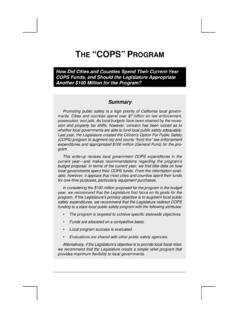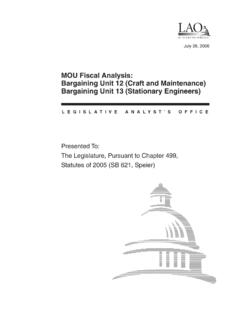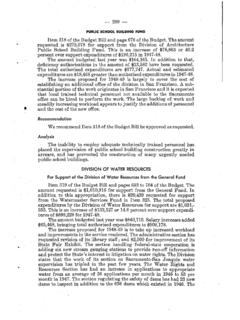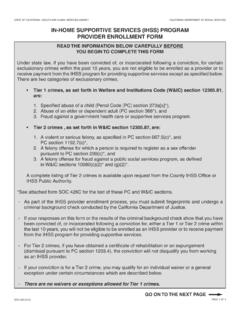Transcription of In-Home Supportive Services (IHSS) Timesheet Processing
1 Presented to:Senate Human Services CommitteeHon. Mike McGuire, ChairIn- home Supportive Services (IHSS) Timesheet ProcessingNovember 1, 2016 YEARS OFSERVICEL E G I S L A T I V E A N A L Y S T S O F F I C E 1 LEGISLATIVE ANALYST S OFFICEN ovember 1, 2016 How Are IHSS Timesheets Processed? Providers those who are compensated by the state to provide care for IHSS recipients ( consumers ) complete a handwritten paper Timesheet listing the hours they worked over a given pay period. (Each month contains two pay periods.) Both the provider and consumer sign the Timesheet to verify the claimed hours. Providers submit timesheets by mail to a central Timesheet Processing facility located in Chico. Timesheets are processed electronically through scanners and may also be reviewed by facility staff. Currently, the state contracts for this service.
2 In order to be processed successfully, a Timesheet must be signed and the hours claimed must not confl ict with: (1) the recipient s authorized hours, (2) hours other providers are claiming for work with the same recipient, (3) the provider s leave or termination status, and (4) recently enacted provider overtime caps. If the central Timesheet Processing facility determines the recipient completed the Timesheet correctly, the facility then notifi es the State Controller s Offi ce to issue the provider a paycheck and the Employment Development Department to send the provider a Timesheet for the next pay period. The Department of Social Services (DSS) which administers the program has set a goal of Processing IHSS timesheets within ten business days. It is our understanding that the Department has generally met that goal. Overview of IHSS Timesheet Processing2 LEGISLATIVE ANALYST S OFFICEN ovember 1, 2016 What Is a Timesheet Exception ?
3 Sometimes, timesheets are submitted with errors, known as exceptions. Data from DSS show about 14,000 or percent of timesheets are submitted each month (over two pay periods) with hard exceptions errors that cannot be resolved by Processing staff without delay. What Causes Timesheet Exceptions? There are two primary types of Timesheet exceptions: soft exceptions and hard exceptions. Soft exception. A soft exception occurs when electronic scanners cannot recognize the handwritten entries on the Timesheet . Soft exceptions are resolved by Timesheet Processing facility staff who may use their judgment to determine, for example, if the number written on the Timesheet is a 4 or a 9 . (In some cases, staff is unable to decipher the writing on a Timesheet . In these cases, the error is processed as a hard exception.) Soft exceptions are not counted in state Timesheet exception data because they are resolved without delay.
4 Hard exception. A hard exception occurs when the electronic scanner identifi es errors that cannot be resolved by facility staff. In these cases, the hard exception is sent to county staff so they may contact the provider and resolve the issue. The fi gure on page 3 displays types of hard exceptions and their frequency, based on a point-in-time snapshot of Timesheet exceptions from Timesheet Exceptions3 LEGISLATIVE ANALYST S OFFICEN ovember 1, 2016 How Long Does it Take to Resolve a Hard Exception? The length of time it takes to resolve hard exceptions may vary. In some cases, counties may need to mediate disputes among providers and consumers and develop an action plan for how to proceed with the assignment and claiming of hours. This may occur, for example, if a consumer has multiple providers and the providers combined Timesheet totals exceed the recipient s authorized hours for the month.
5 Point-in-time data from the DSS show that of the 14,503 June 2016 timesheets with exceptions submitted to the Timesheet Processing facility by July 11, 2016, 85 percent were resolved within ten Timesheet Exceptions (Continued)Status of June 2016 Timesheets With Hard ExceptionsaTimesheet StatusNumber of TimesheetsPercent of TotalTimesheets With Pending ExceptionsMissing provider or recipient signature 336 2%Provider ineligible for some or all of pay period 328 2 Duplicate Timesheet for pay period already processed 249 2 Timesheet submitted with no entries 228 2No remaining provider or recipient authorized hours 195 1 Unreadable or missing entries 178 1 Time claimed exceeds 24 hours in a day 130 1 Timesheet claiming hours for future days 101 1 Other exceptions 27 Subtotal, Pending Exceptions (1,772)(12%)Timesheets With Resolved Exceptions 12,73188% Total, Timesheets With Hard Exceptions 14,503 100%a Data provided by Department of Social Services , as of July 11, ANALYST S OFFICEN ovember 1, 2016 The fi gure below displays how many hard exceptions from June 2016 timesheets were resolved within the same day, ten days, 41 days, and how many were pending as of July 11, 2016.
6 About 3 percent of hard exceptions took longer than 11 days to resolve. What Happens After an Exception Is Resolved? When providers need to correct the errors made on their original timesheets, the county issues new timesheets so they may complete them with corrections. Providers submit the corrected timesheets to the central Timesheet Processing facility, which restarts the Timesheet process. IHSS Timesheet Exceptions (Continued)Resolution Status of June 2016 Timesheets With Hard ExceptionsaException StatusTimesheetsPercent of TotalResolved in the same day 2,439 17%Resolved within 1-10 days 9,908 68 Resolved within 11-41 days 384 3 Pending resolution as of July 11, 2016 1,772 12 Timesheets With Hard Exceptions 14,503 100%a Data provided by Department of Social Services , as of July 11, ANALYST S OFFICEN ovember 1, 2016 The Bottom Line: What Are the Consequences of Timesheet Exceptions?
7 Providers. The provider will not receive compensation for the pay period of the Timesheet with exceptions until the exceptions have been resolved. Providers may continue to submit timesheets and receive pay for subsequent pay periods, even if they have a pending exception from a previous pay period. However, because providers with pending exceptions will not automatically receive a Timesheet for the subsequent pay period, they will need to contact the county to receive a Timesheet for the subsequent pay period. Consumers. Consumers may continue to receive Services from providers with a pending Timesheet exception. Counties. Counties must contact IHSS providers and consumers to address hard exceptions identifi ed in timesheets. This time-consuming process can become backlogged during high-volume times of Timesheet Processing . IHSS Timesheet Exceptions (Continued)


















